- About Ramapo
- Academics
- Admissions & Aid
- Student Life
- Athletics
- Alumni
- Arts & Community
- Quick Links
- Apply
- Visit
- Give
History and Monuments
A Civic Association at Ramapo College, 1979 – 2020
The United Jewish Community of Bergen County established the Resource Center for Holocaust and Genocide Studies in 1979. It opened one year later as an independent nonprofit organization on the campus of Ramapo College. Holocaust survivors, such as Robert Bell, counted prominently among the Center’s founders. They and their cofounders, including children of survivors, recognized the status of the Holocaust as a pivotal event in their own lives and “as a tragedy that has shaken our world.” The Resource Center amassed a library of over 1,000 volumes and video recordings to help the campus and county communities wrestle with the theological, philosophical, and political implications of the Shoah and other genocides.
The Resource Center’s founding director, Rabbi Joseph Rudavsky, identified and developed the independent organizations first areas of operation. He offered classes for Ramapo students and planned Holocaust and genocide pedagogy workshops for educators in our region —years before the state’s mandate for Holocaust education came into force in 1994. Under Rabbi Rudovsky’s direction, the Resource Center offered the community opportunities to speak with survivors of the Holocaust and the Armenian Genocide, as well as Bosnian high school students. It brought hundreds of high-school students to Ramapo College for annual educational opportunities and hosted a yearly Breakfast for Clergy. The Resource Center additionally hosted art exhibitions, lectures, and film series. For some time, it also awarded a member of the local community with the “Raoul Wallenberg Humanitarian Leadership Award.”
Click to Read a 1986 Statement on History, Purposes, and Functions
Rabbi Rudavsky built upon the legacy of his father, Oren Rudavsky, a documentary filmmaker who specialized in recording Holocaust testimonies for educational purposes. In partnership with the Fortunoff Video Archive for Holocaust Testimonies at Yale University, the Resource Center video-recorded 136 testimonies from survivors who had settled in our region. The collection has been digitized and is accessible via the Ramapo College internal network. Students continue to make sensitive use of the recordings for their coursework.
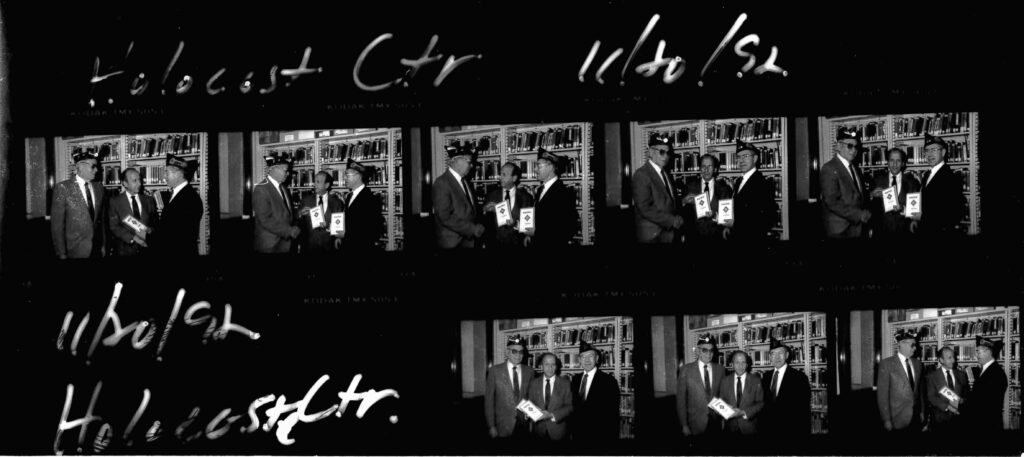
Award Ceremony, 1992
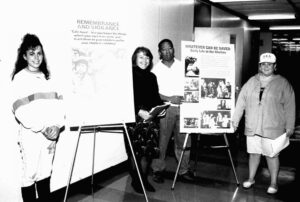
Student Projects on Display, 1993
Ramapo’s Center for Holocaust and Genocide Studies
Rabbi Rudovsky retired as director in 1996. Five years later, to secure the Resource Center’s well-functioning in perpetuity, the directors agreed to integrate their organization fully into Ramapo College as the Center for Holocaust and Genocide Studies. This positioned the Center’s second director, Dr. Michael Riff, to build upon the foundation laid by Rabbi Rudovsky and his board. Dr. Riff developed additional courses which continue to be taught at Ramapo College, invited world-class scholars to speak on campus, initiated study-abroad programs, and organized a number of art exhibits. He also sustained with the tradition of convening regular Holocaust and Genocide Educator Workshops, which the William Gumpert Foundation sponsored between 2007 and 2012.
In 2009, Dr. Riff and Dr. Rebecca Root (current CHGS advisory board member) established a minor in Human Rights and Genocide Studies, drawing from multiple disciplines and attracting a wide range of students upon its launch in 2010. Dr. Root served as the first convener of the minor, a responsibility now shouldered by Dr. Mia Serban. CHGS courses can also be used towards the completion of a minor in Jewish Studies.
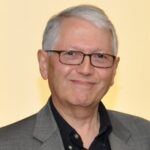
Dr. Michael Riff
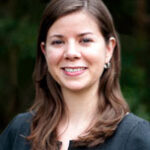
Dr. Rebecca Root
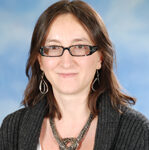
Dr. Mia Serban
The Center carried the Gross Family name between 2014 and 2024. The Gross Family’s transformative contributions to the Center spanned a decade, 2014 – 2024. Beyond its philanthropy, the family also guided the Center, both formally and informally, by making programmatic recommendations and engaging in long term strategy for its future. The Center, Ramapo College, and the Ramapo College Foundation remain grateful to Paul, Gayle, Lauren and Roger Gross for their many years of support and counsel.
Dr. Riff retired in 2021. His successor and the current director, Dr. Jacob Ari Labendz, joined Ramapo College in Fall 2022. With financial support from the William Gumpert Foundation, the Center for Holocaust and Genocide Studies (CHGS) hired Colleen Tambuscio as our first Pedagogy Programs Administrator. She works closely with the Teacher Education Program at Ramapo College and with schools throughout Northern New Jersey and Southern New York. Dr. Labendz also established an internship program for Ramapo students.
The CHGS inaugurated an academic publishing symposium in Fall 2023, with support from the S. Rubenstein Family Foundation. The program operates in four-year cycles. In the first two years, the CHGS invites scholars from institutions around the world to present and develop papers on a selected theme. The third year is dedicated to publishing the chapters as an edited volume with a university press. The fourth year is for planning the next cycle.
The CHGS is associated with two scholarships available to Ramapo College Students: The Clara and Morton Richmond Scholarship and the Ernst Aronsohn Memorial Scholarship. It also undertook technological upgrades thanks to a generous donation from Stanley Richmond.
Since its inception, the CHGS has depended upon the advice and support of an advisory board.
Campus Monuments
You will find two Holocaust memorials on the campus of Ramapo College.
Judith Peck, “One Man in Memory of Six Million” (1973)
In 1973, Judith Peck, then a member of the Ramapo College faculty, created “One Man in Memory of Six Million.” She took inspiration from a harrowing tale of the Holocaust shared by a tour guide on her family’s visit to Hungary in 1970. Ms. Pick first crafted the statue with styrofoam tubes, later recreating it with fiberglass and resin. Yvonne Mannheimer Lorber commissioned a bronze casting in 2010, dedicating it to the remembrance of the Mannheimer Family. The CHGS and Ramapo College held a rededication ceremony for the statue on November 8, 2023, a date that corresponded with the eighty-fifth anniversary of Kristallnacht. Participants lit seven candles, six of which honored the six-million victims of the Holocaust. The seventh symbolized hope for the future.
The Student Government Association inspired the rededication by passing a unanimous bill calling for better lighting and signage around the statue. Arthur Barchenko, a member of the CHGS Advisory Board, designed and donated the lighting. To this day, the statue remains a powerful reminder for students of the atrocities of the past and our responsibilities to the present and future.
Paul Noah Perces, “Holocaust” (1989)
Paul Noah Perces created his sculpture, “Holocaust,” in 1989. He signed a one-year renewable loan agreement with Ramapo College in February 1994. The campus community gathered to install the piece prominently in the library at a dedication on April 7, in commemoration of Yom HaShoah. Soon after, the College relocated “Holocaust” to the center of the Grove, where it may be observed by all visitors.
Czech Torah from Kolín (ca. 1775)
The Center welcomed a Czech Memorial Scroll to Ramapo Campus at a moving ceremony on May 1, 2023. It is on permanent loan from the Memorial Scrolls Trust. Before WWII, the Torah belonged to the Jewish community of Kolín, a city forty miles east of Prague. Experts estimate that it was written in the mid-eighteenth century. The Center thanks Cipora Schwartz and Dr. Susan Gaulden for their generosity in helping us obtain our scroll. On November 3, 2024, the CHGS partnered with the Dresner Center for Collaborative Programs and Learning and Temple Beth Tikvah to organize a commemorative gathering of Czech Memorial Scrolls from across our region.
Researched and written by CHGS student-interns Bella Apgar and Keya Naik.
Copyright ©2025 Ramapo College Of New Jersey. Statements And Policies. Contact Webmaster.
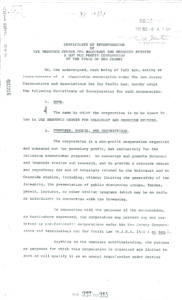
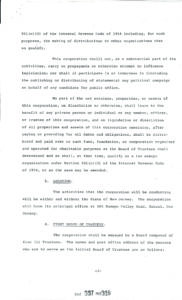
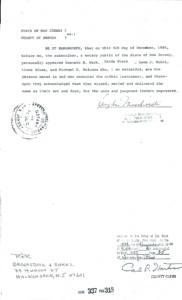
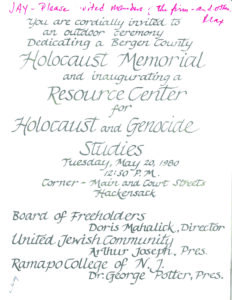
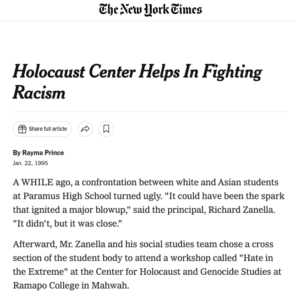
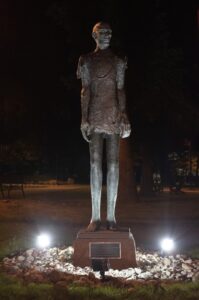
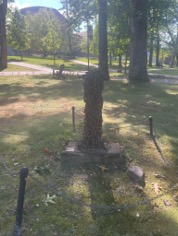
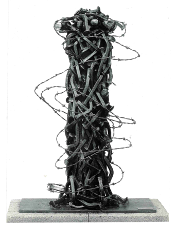
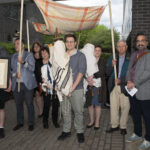

Follow Us!